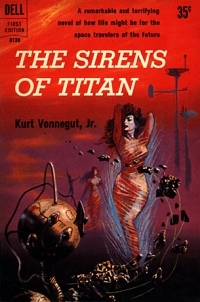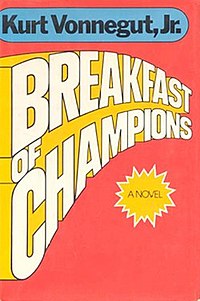Since I’m thinking about the late, great Kurt Vonnegut, I decided to do a short summary of his works here, along with my take on them and my star ranking of each. Vonnegut graded his own books in the course of his collection Palm Sunday, and I’ve included those rankings here too. Keep in mind that it’s been many years since I’ve read some of these books, so my remembrances of a few might be a bit off.
Player Piano (1952) — 3 1/2 stars (Vonnegut’s own grade: B)
A relatively straightforward satire of a dystopian future about mechanization and its effects on blue-collar workers a la Huxley’s Brave New World. Vonnegut was still finding his voice here, so you’ll find relatively little of his trademark humor or authorial noodling. Some of the symbolism is a bit clunky and obvious. Yet his deep and abiding humanism still shines through every page.
 The Sirens of Titan (1959) — 4 1/2 stars (Vonnegut’s own grade: A)
The Sirens of Titan (1959) — 4 1/2 stars (Vonnegut’s own grade: A)
The classic space-faring science fiction story as written by Salvador Dali and Lenny Bruce after smoking lots of weed. Vonnegut comes out after a seven-year hiatus swinging with a fully developed voice. The cosmic speculation here about the purpose(lessness) of human existence is both cynical and mindblowing.
Mother Night (1961) — 5 stars (Vonnegut’s own grade: A)
An angry and morally biting story about a Nazi turncoat on death row in Israel post-World War II. This is perhaps the most conventional of all Vonnegut’s novels, and one of his most heartbreaking. The moral, as spelled out in the author’s own preface: “We are who we pretend to be, so we must be careful who we pretend to be.” Don’t miss the Nick Nolte film adaptation either.
Canary in a Cathouse (1961) — See Welcome to the Monkey House below.
Cat’s Cradle (1963) — 5 stars (Vonnegut’s own grade: A+)
The novel pits the cold and brutal scientific worldview of Dr. Felix Hoenikker against the ludicrous made-up religion of Bokononism. The adherents of Bokononism engage in silly rituals, speak gibberish to one another, hold contradictory beliefs about God, and have lots of sex. On a purely metaphysical level, the Bokononists are dead wrong about how the universe works; and yet Hoenikker’s scientific truths bring the world nothing but misery and apocalypse.
God Bless You, Mr. Rosewater (1965) — 4 stars (Vonnegut’s own grade: A)
Vonnegut’s ode to community and civic responsibility, and how they can go horribly awry. A comic American novel about an eccentric philanthropist and the lawyer who tries to bring about his downfall in the tradition of Sinclair Lewis. I believe this is the novel that introduces Vonnegut’s fictional alter ego Kilgore Trout.
Slaughterhouse-Five (1969) — 5 stars (Vonnegut’s own grade: A+)
Vonnegut writes about Billy Pilgrim, a World War II veteran and witness to the firebombing of Dresden (as Vonnegut himself was). Like the Bokononists, Billy’s defense against the horrors of the world is to retreat into insanity. He decides that he’s “come unstuck in time” and become the plaything of a fantastic race of aliens who experience their lives by dipping in and out of time at their leisure. The film adaptation is… eh.
Welcome to the Monkey House (1968) — 5 stars (Vonnegut’s own grade: B-)
The seminal collection of KV short stories, repackaging almost all of the stories from Canary in a Cathouse and adding lots more. Includes classics such as “Harrison Bergeron,” “Report on the Barnhouse Effect,” and the title story. Alternately hysterical, wistful, psychedelic, and just plain groovy. Yes, there are a couple of clunkers here, but the magic shines through.
Happy Birthday, Wanda June (1971) — 2 1/2 stars (Vonnegut’s own grade: D)
Vonnegut’s fledgling effort at stage drama, and not a particularly successful one. All of the characters sound like — well, like Kurt Vonnegut.
Between Time and Timbuktu (1972) — 3 stars
A mishmash of KV’s novels up to that point, with a thin connecting thread in between them. An interesting introduction to the work of Vonnegut, but if you’ve already read the novels there’s nothing much to see here.
 Breakfast of Champions (1973) — 5 stars (Vonnegut’s own grade: C)
Breakfast of Champions (1973) — 5 stars (Vonnegut’s own grade: C)
This is the novel where Vonnegut either started walking or water or began to completely lose his marbles, depending on who you ask. Written in the style of a children’s book and including copious childish illustrations (some scatological), the book spotlights Kilgore Trout and also features as a major secondary character one Kurt Vonnegut, author of Breakfast of Champions. There was a major film adaptation in the ’90s, which I’m not quite sure anyone actually saw.
Wampeters, Foma and Granfalloons (1974) — 4 stars
A collection of essays and other nonfiction. Includes his famous meditation on science fiction (“I have been a soreheaded occupant of a file drawer labeled ‘Science Fiction’… and I would like out, particularly since so many serious critics regularly mistake the drawer for a urinal”), among other gems.
Slapstick (1975) — 2 1/2 stars (Vonnegut’s own grade: D)
Widely acknowledged to be a low point in Vonnegut’s career, Slapstick is science fiction satire that not even the author can take seriously. It’s about former president of the U.S. Dr. Wilbur Daffodil-11 Swain, who lives in the ruins of the Empire State Building with — well, it just gets more incoherent from there. Adapted into another film nobody saw, Slapstick (Of Another Kind).
Jailbird (1979) — 4 stars (Vonnegut’s own grade: A)
A solid return to form for Vonnegut, also featuring the return of Kilgore Trout. Probably the most political novel KV had written since Mother Night, this novel is suffused with the ghosts of Watergate, the Sacco-Vanzetti trial, and Vietnam. Perhaps not one of his most memorable books.
Sun Moon Star (1980), with Ivan Chermayeff — unratable
A large coffee table book that I think is intended to be a children’s book, with illustrations by Ivan Chermayeff. It reads pretty much like you’d expect a children’s book by Kurt Vonnegut to read. It will probably set you back $20 or $30 for a copy, which means you’ll be paying about 50 cents a word, which is too much.
Palm Sunday (1981) — 4 stars (Vonnegut’s own grade: C)
Another classic collection of Vonnegut nonfiction, along with a single science fiction story that’s worth the price of admission alone: “The Big Space Fuck,” which features humanity’s attempt to colonize the galaxy by launching a spaceship filled with human sperm. Also contains Vonnegut’s attempt to grade his own career and a description of his failed doctoral thesis about how to graph stories.
Deadeye Dick (1982) — 4 stars
A rather peculiar and cynical satire about a boy who accidentally kills his mother a stranger as a child, and who spends the rest of his life atoning for it. Includes some stock Vonnegut characters from other novels, and large sections written as stage drama.
 Galápagos (1985) — 5 stars
Galápagos (1985) — 5 stars
Vonnegut at the top of his game. Narrated by a ghost living on the Galápagos Islands, where the remainder of humanity has (d)evolved into a species of dumb, happy seal creatures. And that’s just the frame story. Similar to The Sirens of Titan in its epic scope and speculation on the purpose of human intelligence, but this one always makes me cry at the end.
Bluebeard (1987) — 4 1/2 stars
Vonnegut takes on the art world through the eyes of a one-eyed artist, previously a cameo character in Breakfast of Champions. Stuffed full of metaphor and fairy tale allusion, this novel continued Vonnegut’s streak in the ’80s of hard-hitting, substantial, and occasionally heartbreaking books.
Hocus Pocus (1990) — 3 stars
Another of KV’s low points in his career. The conceit of the novel is interesting (a novel written on randomly ordered scraps of paper), but its meditations on the prison system are perhaps not quite as interesting or urgent as they could be. This is probably the Vonnegut novel I remember least well.
Fates Worse Than Death (1990) — 3 stars
The third collection of Vonnegut essays. Like most such nonfictional collections in an author’s later career, by this point we’ve pretty much read everything KV has to say.
Timequake (1997) — 2 1/2 stars
KV’s last gasp in the novel format, and it shows. This book featuring Kilgore Trout caught in a Phildickian time warp was resurrected from an earlier, failed novel that the author couldn’t finish. And so the story is interspersed with lots of breaking down of the fourth wall and some rather depressing authorial musings. Vonnegut’s best work always showed a delicate balance between humor and pain; in Timequake, he teetered a little too far to the latter side.
Bagombo Snuff Box (1999) — 4 stars
All the Vonnegut stories that didn’t see print in Welcome to the Monkey House. While not as essential a collection as Monkey House was, these tales are disarmingly good and, for the most part, not science fictional. This certainly doesn’t feel like a scraping of the bottom of the barrel. If nothing else, this book demonstrates how good Vonnegut was at simple, non-pyrotechnic storytelling.
God Bless You, Dr. Kevorkian (1999) — 3 1/2 stars
A collection of very brief vignettes, originally broadcast as radio pieces on NPR. Vonnegut goes to Heaven and “interviews” such people as Hitler, Shakespeare, and (of course) Kilgore Trout. Amusing enough, but very slight and not exactly essential to anyone but Vonnegut completists.
A Man Without a Country (2005) — unrated
The one work of Vonnegut’s I haven’t read. A collection of (from what I gather) highly political essays railing about the Iraq War and the incompetence of the Bush Administration.
***
That’s the whole shebang. So which one is your favorite?